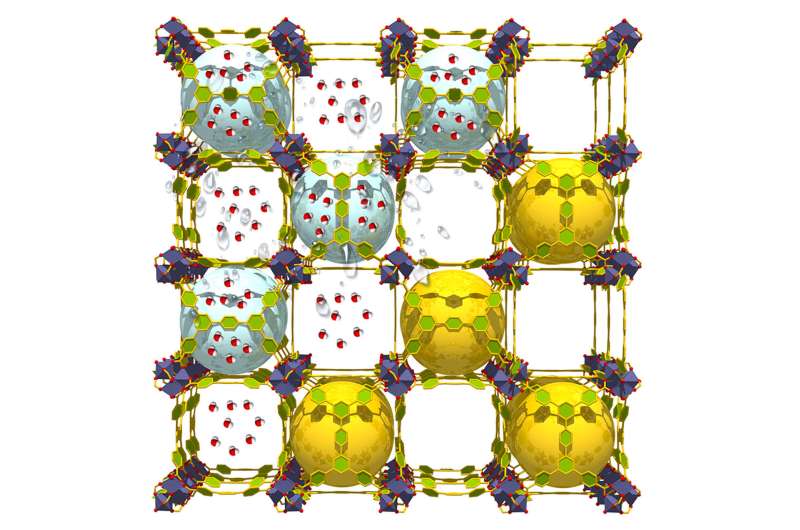Super-adsorbent MOF captures twice its weight in water

Material chemists in the Kingdom of Saudi Arabia have developed a superporous solid made up of a patchwork of metal ions and organic linkers (a metal-organic framework, or MOF) that can suck up to 200% of its own weight in atmospheric moisture. The technology, presented January 11 in the journal Chem, could be applied to regulating humidity levels, particularly in confined environments such as aircraft cabins and air-conditioned buildings.
"I am not surprised that MOFs surpass existing solids in their water capacity uptake," says senior author Mohamed Eddaoudi, of the King Abdullah University of Science and Technology. "MOFs' modularity, ultra-high surface areas, and large pore volumes, combined with the ability to control the pore surface functionality and pore size and shape, place MOFs as prospective candidates for energy-efficient and cost-effective humidity-control systems."
Permanently porous superabsorbent materials, with the combined requisite hydrolytic stability and significant water uptake, are challenging to make because most porous solids are either too dense or too reactive to water. Eddaoudi and his collaborators overcame this problem with their design of Cr-soc-MOF-1, a MOF made up of chromium ions linked together by carboxylate-based organic ligands that leave well-defined cages and channels for water to collect. The chromium ions are held in place by carboxylate moieties in a bidentate fashion, forming a rigid hexacarboxylate oxo-trinuclear chromium(III) cluster, ensureing that the resultant Cr-soc-MOF-1 adsorbent possess the required hydrolytic stability.
The researchers tested Cr-soc-MOF-1's water adsorption properties and found that as the relative humidity increases up to 55%, the adsorbed amount of water gradually increases, followed by a steep water uptake between 60 and 75% relative humidity. As this point, the MOF reaches its maximum capacity, where it can capture nearly twice its weight in adsorbed water (1.95 g/g). Markedly, Cr-soc-MOF-1 maintains its structural integrity and performance over more than 100 tested water vapor adsorption-desorption cycles.
Now that the researchers have a material that can readily regulate humidity (absorbs and desorbs), they are engaged in collaborative work to develop ways to create a humidity-control device.
"In 20 years we went from a folklore that MOFs are not stable and are just pretty structures to MOFs with unprecedented hydrolytic stability and exceptional properties relevant to energy security and environmental sustainability," Eddaoudi says. "There is no doubt in my mind that the future of MOFs is bright, and the only limitation will be the scientist's imagination on where MOFs can be deployed effectively and efficiently."
More information: Chem, Abtab et al.: "Reticular Chemistry in Action: A Hydrolytically Stable MOF Capturing Twice Its Weight in Adsorbed Water" www.cell.com/chem/fulltext/S2451-9294(17)30473-4 , DOI: 10.1016/j.chempr.2017.11.005
Journal information: Chem
Provided by Cell Press




















